七年级英语:Lesson 16(教学实录)
- 格式:docx
- 大小:261.32 KB
- 文档页数:5
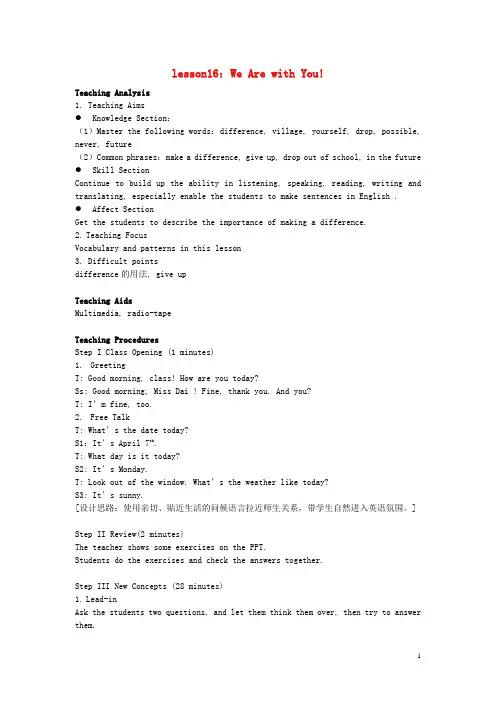
lesson16:We Are with You!Teaching Analysis1. Teaching Aims●Knowledge Section:(1)Master the following words:difference, village, yourself, drop, possible, never, future(2)Common phrases:make a difference, give up, drop out of school, in the future ●Skill SectionContinue to build up the ability in listening, speaking, reading, writing and translating, especially enable the students to make sentences in English .●Affect SectionGet the students to describe the importance of making a difference.2.Teaching FocusVocabulary and patterns in this lesson3. Difficult pointsdifference的用法, give upTeaching AidsMultimedia, radio-tapeTeaching ProceduresStep I Class Opening (1 minutes)1. GreetingT: Good morning, class! How are you today?Ss: Good morning, Miss Dai ! Fine, thank you. And you?T: I’m fine, too.2. Free TalkT: What’s the date today?S1:It’s April 7th.T: What day is it today?S2: It’s Monday.T: Look out of the window. What’s the weather like today?S3: It’s sunny.[设计思路:使用亲切、贴近生活的问候语言拉近师生关系,带学生自然进入英语氛围。
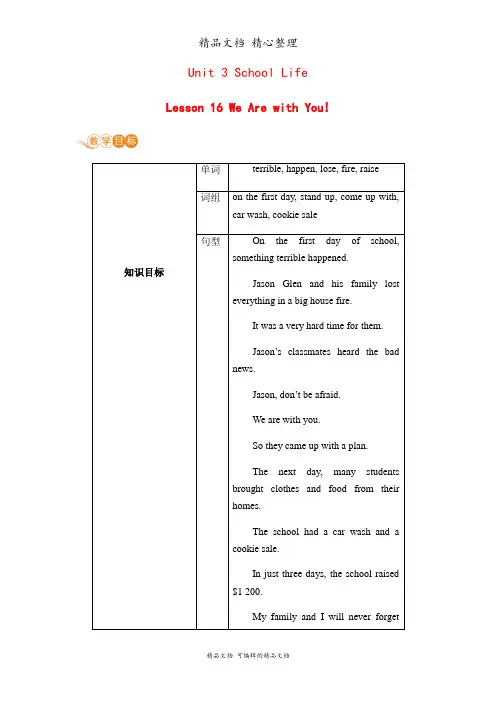
Unit 3 School LifeLesson 16 We Are with You!单词terrible, happen, lose, fire, raise1.学会运用一般现在时和一般过去时。
2.能听懂关于筹集善款,帮助有困难的同学们的文章。
正确使用本课的词和短语,分辨、会用terrible, happen, lose, fire, raise, on the first day, stand up, come up with, car wash, cookie sale。
Step 1.Lead inLeading in 【情景1】Warm up:Show some pictures about disasters.Ask the students to think about ways to help the people in trouble.Teacher points to the pictures and asks questions: T:What are the people doing?S1:They are putting out the fire.T:After the fire, what can you see?S2:Something broken, such as broken houses and broken things.T:What can we do to help put out the fire?S3:We can call 119.S4:We can take much water there.T:After the fire, what can we do?S5:We can take the poor people home.S6:We can give them some money and clothes.Leading in 【情景2】Group work:Ask the students to work in groups and discuss the following questions:How can we help the people in trouble?The students can create different situations to practice them.S1:I will give them some food and clothes.S2:They must have enough water.S3:I want to live with them.S4:I want to give them some money.S5:Where can we get much money?S6:We can sell old books and newspapers.S7:What else can we do?S8:We can sell cookies and cakes.I can make cookies and cakes well.After a few minutes, ask the groups to give reports in front of the class.Group 1:My group thinks of many ways to help the people in trouble.We can share the houses with them.We can give them money and clothes, but we don’t have much money.We have to sell old books and newspapers to raise money.We can also sell cookies and cakes.We can make good cookies and cakes.Do you have any other good ways to help the people in trouble? Please tell us about it.…Step 2.Presentation1.Teacher should teach the new words and phrases in this part:terrible, happen, lose, fire, raise, on the first day, stand up, come up with, car wash, cookie sale.Teacher leads the students to learn the new words and phrases.Then make sentences with the new words and phrases.Teacher can use objects and pictures.Teacher points to a picture and asks the students.T:How does the girl feel?S:She feels terrible.T:Now read after me “terrible”.S:Terrible.T:What happened to you?S:I fell down and hurt my leg.T:Read after me “happen”.S:Happen.…2.Pair work:Ask the students to work in pairs to make conversations.Try to use the new words and expressions.S9:John’s home was on fire last night.He lost everything.S10:I’m sorry to hear that.What can we do to help him?S9:We plan to raise some money for him.S10:It’s a good idea.But how can we raise money?S9:I come up with a good idea.We can have a car wash and a cookie sale.StepⅤ.Practice1.Ask the students to retell the story with their own words.2.Ask the students to practice how to give help to others in trouble.S1:I will give him/her some money.S2:I will give him/her some clothes.S3:I will give him/her some food.S4:I will help him/her find a job.S5:I will ask him/her to live with my family.…3.Work in groups:Ask your group members how they raise money for the people in trouble.Write their answers and make a report in front of the class.Now discuss for several minutes.Then ask some groups to show their reports.Group 1:I have many good friends.They are very clever.They come up with many ideas to raise money for the people in trouble.××says he/she can work in a restaurant on weekends.×× says he/she can clean rooms for others.×× says he/she can wash cars for others.Do you have any other good ways? Please tell us about them. Step 3plete Let’s Do It!We have finished Exercise 1 in reading part.Ask the students to finish Exercise 2 and Exercise 3 by themselves.Check the answers in class.Step 4.TaskWork in groups.Imagine you work for a company that helps poor children.What will you do for them? How will you help them? Discuss with your classmates and make a plan.Ask the students to practice for a few minutes.Then let some groups read their passages.1.Learn the new words and expressions by heart.2.Read the text after class.3.Prepare for the next lesson.。
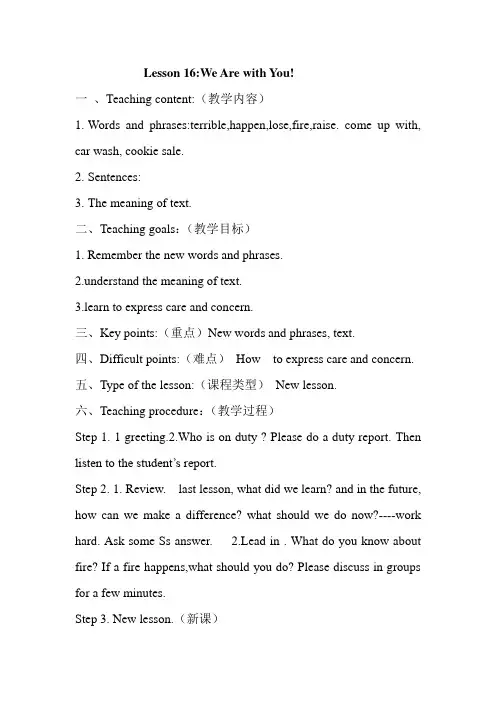
Lesson 16:We Are with You!一、Teaching content:(教学内容)1.Words and phrases:terrible,happen,lose,fire,raise. come up with, car wash, cookie sale.2.Sentences:3.The meaning of text.二、Teaching goals:(教学目标)1. Remember the new words and phrases.2.understand the meaning of text.3.learn to express care and concern.三、Key points:(重点)New words and phrases, text.四、Difficult points:(难点)How to express care and concern.五、Type of the lesson:(课程类型)New lesson.六、Teaching procedure:(教学过程)Step 1. 1 greeting.2.Who is on duty ? Please do a duty report. Then listen to the student’s report.Step 2. 1. Review. last lesson, what did we learn? and in the future, how can we make a difference? what should we do now?----work hard. Ask some Ss answer. 2.Lead in . What do you know about fire? If a fire happens,what should you do? Please discuss in groups for a few minutes.Step 3. New lesson.(新课)Today ,we’ll learn lesson 16 We are with yo u.1.Teach the new words and phrases, make sure the Ss can read it correctly.2.listen to the radio and repeat the new words.3.Listen to the radio the dialogue in Lesson 16.4.Let the Ss read the text and ask answer the following questions:How old is Jason Glen? What happened to Jason Glen and his family? When did it happen? Who helped Jason and his family? How did they help Jason and his family?5.Explain the text (课文讲解)1.Jason Glen is a 12-year-old boy from Riversible High School.杰森·格伦是河畔中学的一个12岁的小男孩。
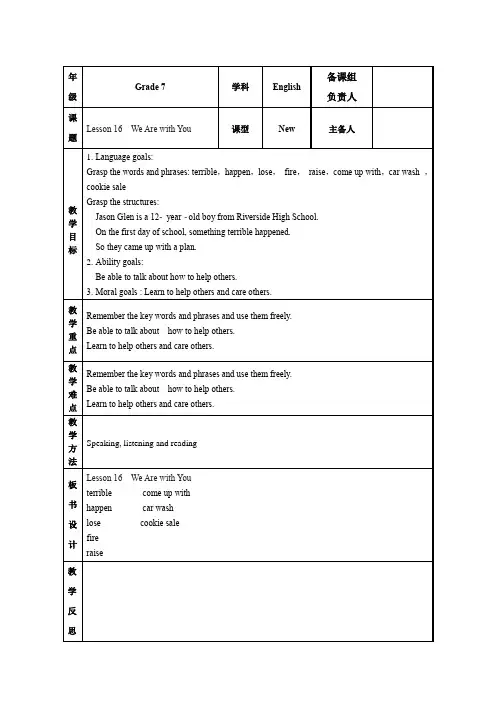
教师活动学生活动二次备课Step I: Led inWho makes a difference to you in your life?How does that person make a difference?Step II: ReviewWho makes a difference to Hao Tongxin in his life?How does that person make a difference?Step III: Lead inWhat happened in the picture?What are they doing in the picture?Why do they wash the car?Step IV:Let’s Do ItMatch the words with the correct meanings.Step V: Let’s Do ItFill in the blanks with the correct forms of the words in the box.fire happen lose news raise1. Did you see the _____ in today’s newspaper?2. Don’t touch the _____! It’s hot!3. I _____ my book yesterday. Can you help me find it?4. The books at my school are too old. Last week, we_______ some money to buy new ones.5. A: I didn’t see you at school yesterday. What_________?B: I hurt my arm.Greet and talk .Review something in last lessonThink about the questions and answer them.Learn the new words and match them with the correct meaning.Use the new words to fill in the blanks. Practise the new words.。
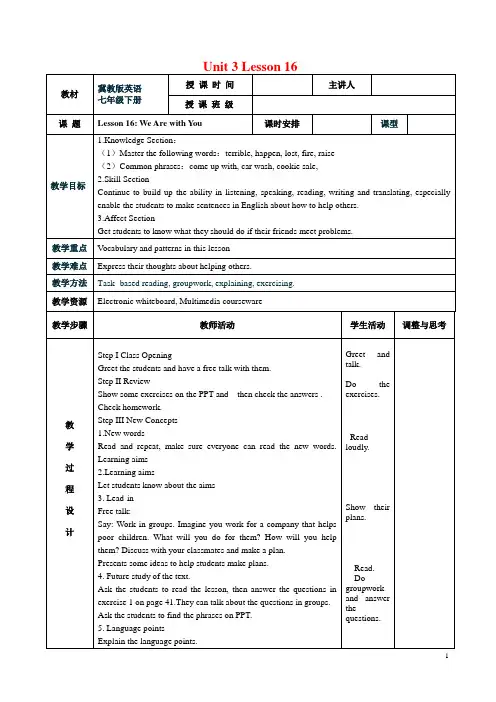
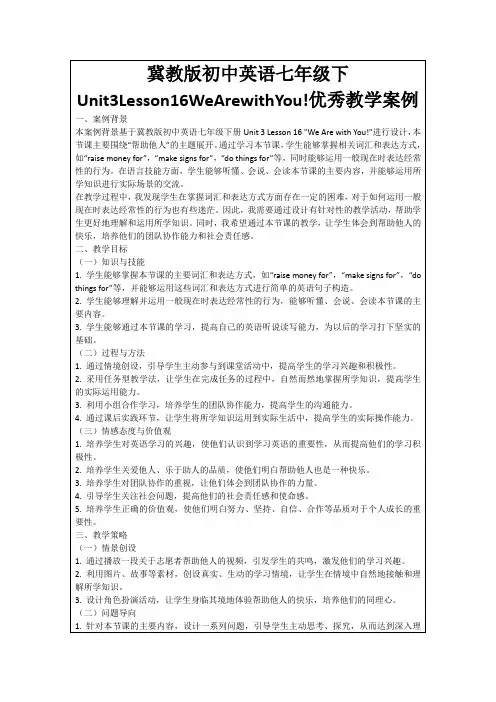
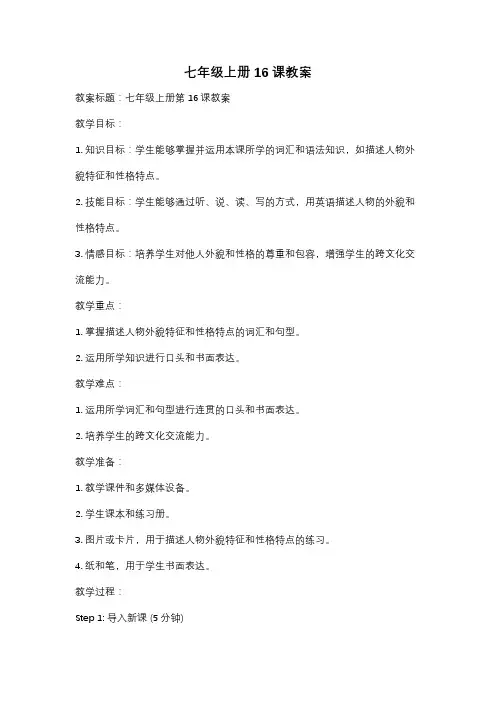
七年级上册16课教案教案标题:七年级上册第16课教案教学目标:1. 知识目标:学生能够掌握并运用本课所学的词汇和语法知识,如描述人物外貌特征和性格特点。
2. 技能目标:学生能够通过听、说、读、写的方式,用英语描述人物的外貌和性格特点。
3. 情感目标:培养学生对他人外貌和性格的尊重和包容,增强学生的跨文化交流能力。
教学重点:1. 掌握描述人物外貌特征和性格特点的词汇和句型。
2. 运用所学知识进行口头和书面表达。
教学难点:1. 运用所学词汇和句型进行连贯的口头和书面表达。
2. 培养学生的跨文化交流能力。
教学准备:1. 教学课件和多媒体设备。
2. 学生课本和练习册。
3. 图片或卡片,用于描述人物外貌特征和性格特点的练习。
4. 纸和笔,用于学生书面表达。
教学过程:Step 1: 导入新课 (5分钟)1. 利用图片或卡片展示不同的人物形象,并引导学生用英语描述这些人物的外貌特征和性格特点。
2. 引发学生的学习兴趣,激发他们对本课话题的思考。
Step 2: 学习新知 (15分钟)1. 通过教师的示范,向学生介绍描述人物外貌特征和性格特点的相关词汇和句型。
2. 引导学生进行口头练习,让他们用所学的词汇和句型描述自己和其他同学的外貌和性格特点。
Step 3: 听说训练 (20分钟)1. 播放录音,让学生听取相关对话和短文,理解并获取信息。
2. 进行听力练习,要求学生回答与人物外貌和性格特点相关的问题。
3. 学生分组进行对话练习,他们可以选择一个人物形象进行描述,并与其他同学进行对话交流。
Step 4: 读写训练 (15分钟)1. 学生阅读课本中相关的阅读材料,理解并获取信息。
2. 学生完成练习册中的相关练习,如填空、选择和改错等。
3. 学生根据所学知识,撰写一篇关于自己或其他同学外貌和性格特点的短文。
Step 5: 拓展延伸 (10分钟)1. 鼓励学生以小组形式进行角色扮演,描述不同人物之间的对话和互动。
2. 学生可以运用所学知识,创作一个小故事,描述其中的人物外貌和性格特点。
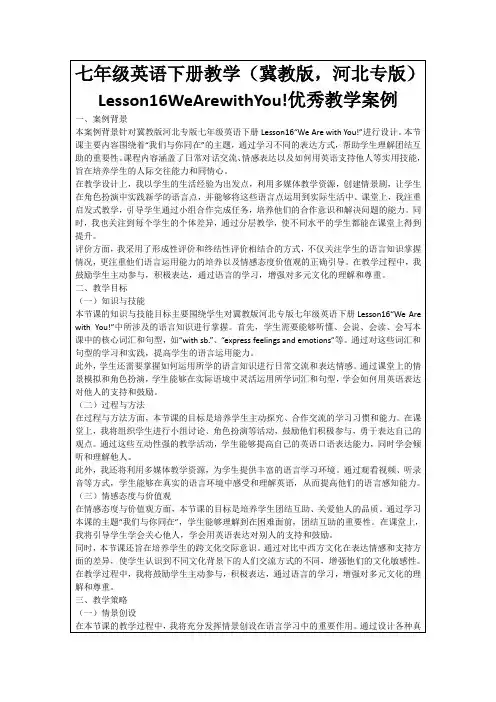
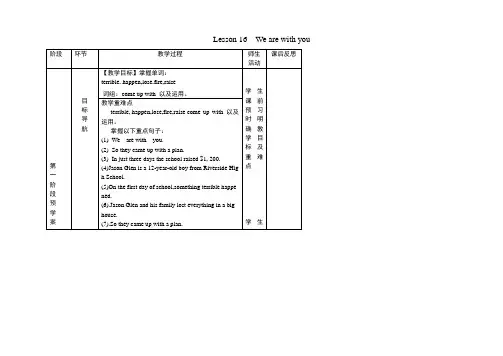
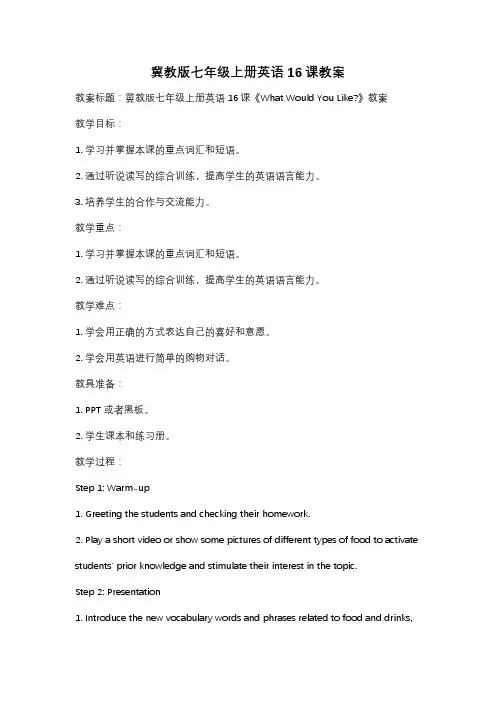
冀教版七年级上册英语16课教案教案标题:冀教版七年级上册英语16课《What Would You Like?》教案教学目标:1. 学习并掌握本课的重点词汇和短语。
2. 通过听说读写的综合训练,提高学生的英语语言能力。
3. 培养学生的合作与交流能力。
教学重点:1. 学习并掌握本课的重点词汇和短语。
2. 通过听说读写的综合训练,提高学生的英语语言能力。
教学难点:1. 学会用正确的方式表达自己的喜好和意愿。
2. 学会用英语进行简单的购物对话。
教具准备:1. PPT或者黑板。
2. 学生课本和练习册。
教学过程:Step 1: Warm-up1. Greeting the students and checking their homework.2. Play a short video or show some pictures of different types of food to activate students' prior knowledge and stimulate their interest in the topic.Step 2: Presentation1. Introduce the new vocabulary words and phrases related to food and drinks,such as "hamburger", "chicken", "noodles", "coffee", "tea", etc.2. Use realia or pictures to help students understand the meaning of the words and practice pronunciation.Step 3: Listening1. Play the audio recording of the dialogue in the textbook.2. Ask students to listen and try to understand the dialogue.3. Play the audio again and have students repeat after the recording to practice pronunciation.Step 4: Speaking1. Divide the class into pairs or small groups.2. Have students role-play the dialogue in pairs, using the new vocabulary words and phrases.3. Monitor the students' conversations and provide feedback and guidance. Step 5: Reading1. Ask students to read the dialogue in the textbook silently.2. Have volunteers read the dialogue aloud to the class.3. Discuss the meaning of any unfamiliar words or phrases and provide explanations if necessary.Step 6: Writing1. Ask students to write a short paragraph about their favorite food or drink.2. Encourage students to use the new vocabulary words and phrases they have learned in their writing.3. Collect and review the students' writing assignments, providing feedback and corrections.Step 7: Consolidation and Extension1. Play a game, such as "Guess the Food", where students take turns describing a food item and the others have to guess what it is.2. Assign extra practice exercises from the textbook or workbook to reinforce the lesson's vocabulary and grammar points.Step 8: Summary and Homework1. Summarize the key points of the lesson and review the new vocabulary words and phrases.2. Assign homework, such as completing the exercises in the workbook or writing a short dialogue using the new vocabulary words and phrases.教学反思:本节课以《What Would You Like?》为主题,通过听说读写的综合训练,旨在提高学生的英语语言能力。
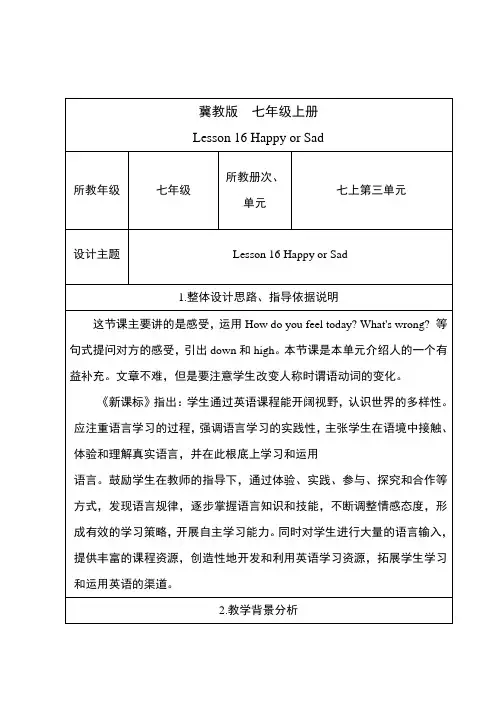
Have a free talk with the students, and help them talk about their hobbies, interests, then teach them the new words and expressions.设计意图:通过聊天使学生以愉快、放松的心情投入本节课的英语学习,吸引学生的注意力,激发他们的好奇心,同时巧妙地引出本课生词。
步骤2:出示学习目标。
设计意图:做到有的放矢,清楚本节课要完成的任务和途经。
步骤3:学习生词。
通过语篇,介绍生词hurt/enough/laugh/How do you feel? I feel... What's wrong? 的用法。
hurt [hə:t] v. 伤害;疼痛adj. 痛的;受伤的The man has a bad toothache.=The man’s tooth hurts badly.=The man has a pain in his tooth.enough [iˈnʌf] adj. &adv. 足够的(地)adj./adv. +enough to do sth.The girl is old enough to go to school.I have enough money to buy the book.laugh[lɑ:f] v. 笑1. He laughed with pleasure when people said he looked like his dad.2. The British don’t laugh at the same joke as the French.donut [ˈdəuˌnʌt] n. 面包圈This shop sells different kinds of donuts. They look good and taste yummy.设计意图:通过图片和语篇引出生词,并了解其用法,提高学生的语用能力。
冀教版英语七下Unit 3《Lesson 16 We Are with You》说课稿一. 教材分析冀教版英语七下Unit 3《Lesson 16 We Are with You》是一篇关于支持与鼓励的课文。
本课的主要内容是让学生学会如何向别人表达支持和鼓励,以及如何在困难时刻给予他人力量。
通过本课的学习,学生能够掌握相关的词汇和表达方式,提高他们的口语交际能力。
二. 学情分析七年级的学生已经具备了一定的英语基础,能够理解和运用一些基本的英语句型和词汇。
然而,他们在口语表达方面还存在一定的困难,特别是在表达支持和鼓励方面。
因此,在教学过程中,需要注重培养学生的口语表达能力,让他们能够在实际情境中运用所学知识。
三. 说教学目标1.知识目标:学生能够掌握本课中的相关词汇和表达方式,如“encourage sb.”、“support sb.”等。
2.能力目标:学生能够运用所学知识,用英语表达支持和鼓励,提高他们的口语交际能力。
3.情感目标:学生能够学会在困难时刻给予他人力量,培养他们的同情心和关爱他人的意识。
四. 说教学重难点1.重点:学生能够掌握本课中的相关词汇和表达方式。
2.难点:学生能够在实际情境中运用所学知识,用英语表达支持和鼓励。
五. 说教学方法与手段1.教学方法:采用情境教学法、交际教学法和任务型教学法,让学生在实际情境中学习和使用英语。
2.教学手段:利用多媒体课件、图片、卡片等辅助教学,提高学生的学习兴趣和参与度。
六. 说教学过程1.导入:通过展示一幅图片,让学生猜测图片中的人物,引出本课的主题。
2.新课呈现:教师展示本课的课文,让学生初步理解课文内容。
3.词汇教学:教师讲解本课中的关键词汇,让学生跟读并模仿。
4.对话练习:学生分组进行对话练习,运用所学词汇和表达方式。
5.情景模拟:教师创设一个情境,让学生扮演不同角色,运用所学知识进行表演。
6.课堂总结:教师对本课内容进行总结,强调支持和鼓励的重要性。
冀教版七年级上册英语16课教案教案标题:冀教版七年级上册英语16课教案课程目标:1. 通过本课的学习,学生将能够掌握关于购物的基本词汇和表达方式。
2. 培养学生的听说能力,能够在实际购物场景中运用所学知识进行交流。
3. 培养学生的合作意识和团队合作能力,通过小组讨论和合作活动提高学生的学习效果。
教学重点:1. 掌握关于购物的基本词汇和表达方式。
2. 能够运用所学知识进行实际购物场景中的交流。
教学难点:1. 运用所学知识进行实际购物场景中的交流。
2. 发展学生的听说能力,提高语言表达的准确性和流利度。
教具准备:1. 多媒体设备。
2. 单词卡片、图片等教具。
教学过程:Step 1: 导入 (5分钟)1. 利用多媒体设备播放与购物相关的图片和视频,引起学生的兴趣。
2. 引导学生讨论他们在日常生活中的购物经历,并鼓励他们分享自己的观点和感受。
Step 2: 新课呈现 (10分钟)1. 准备一些购物相关的单词卡片,向学生展示并教授这些词汇。
2. 通过图片和简单的例句,帮助学生理解这些词汇的意思和用法。
3. 引导学生模仿老师的发音和语调,朗读这些单词。
Step 3: 合作活动 (15分钟)1. 将学生分成小组,每个小组选择一个购物场景,例如超市、商场或者菜市场。
2. 每个小组成员扮演不同的角色,例如顾客、售货员或者导购员,通过对话的方式进行购物交流。
3. 老师在小组之间进行巡回指导,帮助学生纠正发音和语法错误,并提供必要的词汇和表达方式的支持。
Step 4: 拓展活动 (10分钟)1. 老师组织学生进行购物对话的表演,让学生展示他们在购物场景中的表达能力。
2. 学生之间进行互动,提出问题和给予反馈,帮助彼此提高语言表达的准确性和流利度。
Step 5: 小结与反思 (5分钟)1. 老师对本课的重点内容进行小结,并强调学生在购物场景中的语言表达能力的重要性。
2. 学生进行自我评价,反思自己在本课中的学习情况,并提出改进的建议。
Lesson 16 We Are with You!教学目标通过本课的学习,学生能够:1.在语境中正确运用terrible、happen、lose、fire、raise、come up with、car wash、cookie sale等词汇。
2.通过文本阅读,使用寻读(scanning)和根据上下文猜词等阅读策略对信息进行归纳、处理和整合。
3. 熟读课文,并能够复述Jason Glen一家的经历。
4. 感悟人与人之间的互助精神,懂得在别人遇到困难时伸出援手。
语篇研读What: 本课语篇是一篇记叙文,主要讲述了Jason Glen一家不幸发生火灾,Jason的老师和同学们向他伸出援手,帮他一家渡过难关的故事。
Why: 讲述Jason Glen一家不幸发生火灾,同学们向他伸出援手的故事,让学生感悟人与人之间的互助精神,懂得在别人遇到困难时伸出援手。
How:本课语篇主要按事件发生的先后顺序介绍了Jason Glen一家的遭遇。
文章开始介绍Jason家发生了严重的火灾,然后讲述了同学们捐赠物品,并通过洗车和卖甜饼为他筹钱,最后Jason表达了感谢。
教学过程设计理念:以《英语课程标准》核心素养为导向,以单元主题为引领,基于语篇的育人理念,体现《英语课程标准》“学思用创”的英语学习活动观和“教—学—评”一体化设计理念。
续表整体使用语言素材。
同时,对学生当堂课所学的内容进行过程性评价,达到“教—学—评”一体的学习效果【应用实践】Activity 4: Languagepoints and summary 学习知识点,帮助学生解决后续学习中的问题The teacher explains somelanguage points.观察学生是否能够理解、掌握重要知识点,是否能够区分易混词设计意图系统地讲解本节课重点知识,帮助学生形成语言体系【学习理解】Activity 5: Practice 翻译句子Translate the sentences on thePPT.观察学生的完成情况,并根据实际情况给出必要的指导和反馈设计意图练习翻译句子,考查学生对本课重点单词或短语的掌握情况,以便有针对性地布置作业【应用实践】板书设计Lesson 16 We Are with You!A fire happened→Jason’s family lost …→His classmates wanted to …→Many students brought …→They had …→Jason thanked …作业设计基础型作业:1. Read the passage fluently.2. Finish Exercise 2&3 on page 41. 实践型作业:Finish Exercise 4 on page 41.教学反思。
人教版初中英语七年级上册教学设计Lesson 16:Happy or Sad一、Teaching content:(教学内容)1.To master these words:happy, sad.To understand the following:very, tired,enough.2. some useful patterns:How do you feel? I feel happy! I’m NOT fine, thanks. Are you tired? No, I’m not. I just feel sad.二、Teaching goals:(教学目标)1.to learn how to express the feeling of sad and happy.2.to learn more about the feelings.3.to use what was learned in the daily life.三、Key points:(重点)How do you feel? I feel happy! I’m NOT fine, thanks. Are you tired? No, I’m not. I just feel sad.四、Difficult point:(难点)Practice the dialogue.五、Teaching aids:(教学辅助)Recorder, pictures or cards.六、Type of the lesson:(课程类型)Listening and speaking.七、Teaching procedure:(教学过程)Step 1.Warming up.Ask the students questions in the life. You give a student a present and ask his feeling now. Then lead the words: happy, sad.Step 2. Lead in.(引入)Before the class,make the Ss understand the followingquestions:1.How does Jenny feel?2.Is Danny hurt?3.Is Danny tired?Step 3. New lesson.(新课)No. 1 Give the presents that you prepared to the students that do well. Then ask “How do you feel?” Explain it in Chinese when it is necessary. Help them answer “I’m happy.” Then take their presents away and ask “How do you feel now?” Help them answer “I’m sad”No. 2Begin “happy, sad” game in pairs, using the presents that we prepared before the class. The best one will get a present.Let’s sing a song together. Listen to the tape and sing happily after it. Encourage students to sing loudly because what we need is a happy feeling. The students can stand up and do according to the text.Step 4. Play the tape for the Ss to follow.Step 5.Summary. (小结)Sum up sentences:How do you feel?Step 6. Homework.(作业)Finish the activity book.Step 7.Blackboard-writing:(板书)。
七年级上册冀教版英语(教学目标):( detailed详备)1.掌握单词单词 hurt , donut, enough,laugh,right2.短语及句型:laugh at, enough money,How do you feel? I’m/I feelWhat’s wrong? Are you hurt?过程与方法:合作探究,自主学习情感态度与价值观:在生活中用这节课所学的知识,表达自己的感受。
Teaching important points:阅读能力的渗透,能从文中找出有关语段并记录关键信息。
Teaching difficulties:用 How do you feel? What's wrong? 提问对方的感受,并给予一定的开导或建议。
Teaching methods:cooperative research, autonomic learning一、教学设计Part two: Teaching procedures (教学过程):Step1: Class opening and review1.Greetings (Warmup)Good morning, class. Are you happy?2.ReviewClass opening and review(提问上节课单词及知识点)3.LeadinLook at the picture,describe their feeling.Today, we are going to learn:Lesson16:Happy or SadStep2: New concepts( detailed详备)一、出示学习目标过渡语:First ,let’s read the learning goals together.1.我要掌握本课单词 , hurt , donut, enough,laugh 短语及句型:laugh at , enough money, How do you feel? I’m/I feel…,What’s wrong? Are you hurt?2. 我要认真学好本节课,大胆发言,展示自己的个人魅力。
初中英语标准教材
七年级英语:Lesson 16(教学
实录)
Learning English is conducive to understanding the customs and culture of other
countries, reading foreign books, etc.
学校:______________________
班级:______________________
科目:______________________
教师:______________________
--- 专业教学设计系列下载即可用 ---
七年级英语:Lesson 16(教学实录)
Step 1 Revision
Books closed! Revise the story in SB page 15, Part 1. Ask the questions in SB page 15, Part 2.
Step 2 Word families
SB page 16, Part 1. Speech Cassette .
Practise the pronunciation of these words. Pay special attention to the/u/ sound: make sure the Ss do not prolong it. Use flashcards to practise the words in the usual way. /(+/is a new sound. (See Appendix Ⅱ in TB1.)
Wb , Ex. 1. The answers are: good, book, Who, Sue.
Ask the Ss to distinguish/u/from/u:/when reading what
Polly says.
Step 3 Stress and intonation
SB page 16, Part 2. Speech Cassette .
Get the Ss to show the stress and intonation with gestures as they say these sentences.
Step 4 Presentation
Ask a student of his/her plans for one day next week. Get other Ss to ask questions about other days. Then ask e. g. Can he/she go shopping on Tuesday? Help the Ss to reply No, he/she can't.
He's/She's going to play basketball.
Pairwork:Ss write down their plans for next week, then ask their partner Can you go shopping on Friday? etc.
Step 5 Ask and answer
Wb , Ex. 2. Ss ask two friends about their plans for next week. Get some Ss to report their answers.
Step 6 Checkpoint 4
Go through the be going to sentences and the adjective forms in Checkpoint 4. Explain any difficulties that the Ss raise. Review the expressions in Checkpoint 4(See page 17 of the TB.)
Step 7 Test
Write this dialogue on the Bb and get the Ss to copy it and fill in the blanks.
Lin Tao:We're going to play football tomorrow.
Sam:Great! ____?
Lin Tao:Sure! You're welcome!
Sam:____?
Lin Tao:We're going to play at two o'clock.
Sam:I see. ____?
Lin Tao:We're going to meet outside the park gate.
Sam: All right! See you tomorrow!
Lin Tao: ____!
Suggested answers:1 Can/May I come?
2 What time are you going to play?
3 Where are you going to meet?
4 See you then. /Goodbye.
Step 8 Writing
Wb , Ex. 3 may be done orally. Then get the Ss to fill in the blanks with suitable answers.
Homework
Finish off the Wokbook exercises.
Learn the contents of Checkpoint 4.
Write down the complete dialogue in Wb Ex. 3 in the exercise books.
XXX图文设计
本文档文字均可以自由修改。